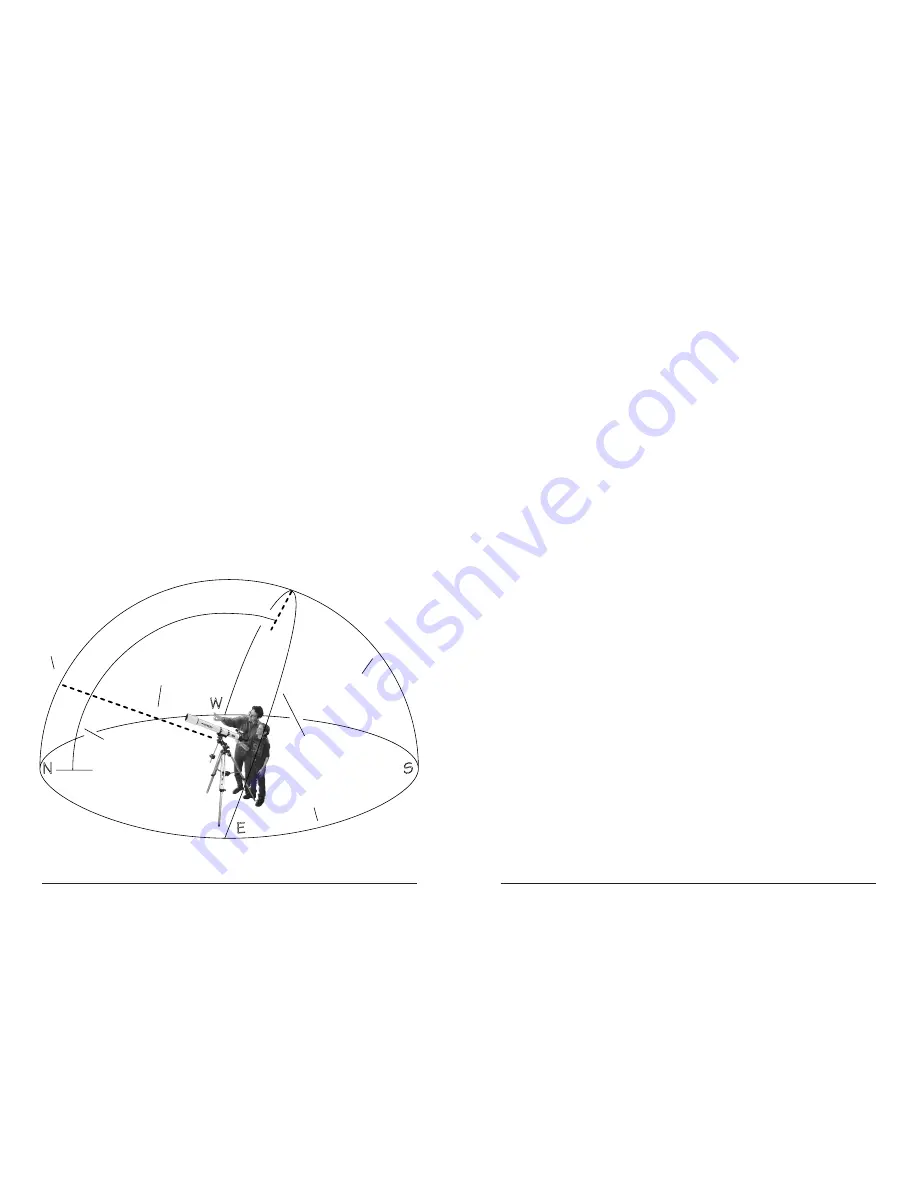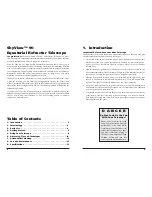
Celestial Equator
Horizon
W
S
N
Zenith
Polaris
Meridian
your North–South
line in the sky
Line up
the Polar Axis
E
➤
➤
➤
➤
➤
✘
★
➤
➤
➤
This angle
is the same
as your latitude
➤
➤
90
ϒ
fro
m p
ole t
o equa
tor
ϒ
9
can easily be kept within the telescope’s field of view.
In the Northern Hemisphere, the Earth’s rotational axis points very close to the
star Polaris, the North Star. This can be easily be demonstrated by pointing at
Polaris with your index finger, and after several minutes the sky will have rotated
from its original position around your finger. When the RA axis is pointed at
Polaris, the telescope can follow the path of the stars as they rotate around their
rotational axis.
There are several methods of aligning the RA axis to the Earth’s rotational axis;
the quickest and easiest method is to align the RA axis to Polaris. This will keep
celestial objects centered in the telescope’s field of view over time with adjust-
ments to the RA slow motion control cable. Swing the optical tube of the telescope
about the declination (DEC) axis so that the tube is parallel to the RA axis. The
DEC setting circle should read +90. Move the tripod so that the RA axis roughly
lines up with Polaris. Adjust the latitude (tilt) of the RA axis up and down until
Polaris is in the center of the field of the finder scope; center Polaris in the cross-
hairs. Then, with the 25mm eyepiece in the focuser,repeat the process of adjusting
the tilt of the RA axis so that Polaris is in the center of the field in the 25mm
eyepiece. Using the T-knob on the side of the mount, lock down your latitude
position . . . this should not have to be adjusted again unless it comes loose or you
go to an observing site several hours North or South of your main site.
Moving the telescope from object to object is accomplished by loosening the RA
and DEC axes locking mechanisms and moving the telescope into the general
area you wish to observe. Lock down the axes by tightening the knobs and locate
the object using the slow motion cables. Moving the tripod is not necessary. To
keep the object in the field of view of the telescope over a period of time, use the
RA slow motion control to keep the object centered. You are moving the RA axis
to follow the sidereal motion of the object around the rotational axis of the Earth.
tube Balancing
Balancing the optical tube to the mount’s two axes of rotation is critical for the
equatorial mount to operate smoothly. If unbalanced, there will be torque put on
one axis of the mount, and the telescope will tend to shift at the most awkward
moment so the heavier end will be lower than the lighter end.
To balance your telescope, set the mount so the DEC setting circle reads +90.
Rotate the telescope in RA until the counterweight is on one side of the mount
and the tube on the other. Leave the RA lock knob loose so the telescope will
rotate freely in the RA axis. Adjust the counterweight so when horizontal, the
telescope does not rotate in RA, and then tighten the RA lock knob. You will
now want to release the DEC axis lock knob and slide the optical tube forwards
and back in the cradle rings until there is no torque in the DEC axis. Now the
telescope is completely balanced and will not move without being touched,
regardless of the axes being locked down.
8
bearing surface by scratching it up.
To carry the telescope out of the house for at-home viewing, you can easily carry
the tube and base separately. Use common sense when moving the telescope.
While the components are not terribly heavy, they are bulky; use caution to avoid
hurting yourself. If in doubt, get someone to help you.
Field use and set-up
When selecting a location for observing, be sure to place the telescope as far away
as possible from direct artificial light, such as street lights, porch lights, and auto-
mobile headlights. The glare from these lights will seriously impair your night
vision. The telescope should be located on a relatively level surface for proper
operation of the mount. You may set it on a sturdy level platform to increase the
height of the eyepiece, but be sure it’s strong enough and does not wobble.
tracking an object
When viewing the night sky, celestial objects will drift out of the telescope’s field
of view due to the rotation of the Earth. Equatorial mounts, like the one that
comes standard with the SkyView, are designed to compensate for this problem.
When aligned correctly with the rotational axis of the Earth, the right assention
(RA) axis of the telescope will match the Earth’s rotation and the celestial objects
Polar Alignment



















